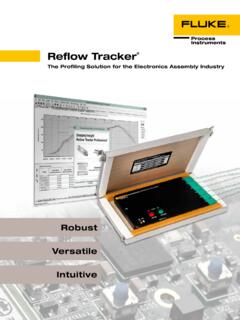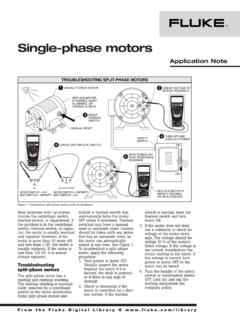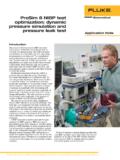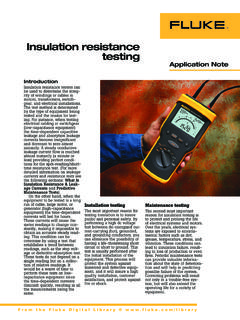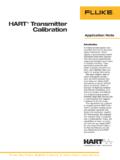Transcription of Troubleshooting HVAC/R systems using refrigerant …
1 Troubleshooting HVAC/R . systems using refrigerant superheat and subcooling Application Note Troubleshooting and servicing The refrigeration cycle refrigeration and air condition- ing systems can be a challeng- Based on the principle that heat ing process for both the entry flows naturally from warmer level and experienced HVAC/R areas to cooler areas, the refrig- technician. Regardless of your eration cycle consists of seven experience, size of the equip- stages: ment, or location, to troubleshoot 1. Compression of hot gas the system it is essential that 2.
2 Cooling you have a solid understanding 3. Condensing of the fundamentals of refrigera- tion including the principles of 4. Subcooling superheat and subcooling. You 5. Expansion also need to have the right tools 6. Evaporation and know-how to apply these principles to use the tool quickly 7. Super heating and efficiently. A basic vapor compression Troubleshooting techniques refrigeration system consists often require simultaneous of four primary components: a knowledge of temperature, pres- metering device ( a capillary sure, voltage, and current values tube, fixed orifice/piston, or a in a system , which means that thermostatic expansion valve), Testing roof-top refrigeration system with a Fluke 561 Infrared a single-function meter won't evaporator, compressor, and Thermometer.
3 Permit a complete analysis of the condenser. system . Frequently, multiple tools (See Figure 1.) Compression are required. energy elevates the vapor pres- This application note provides sure to a boiling point that is information on Troubleshooting below the condensing mediums'. the refrigeration system while temperature. In other words, the applying the principles of super- compressor elevates the boiling heat and subcooling to HVAC/R point of the refrigerant to a point equipment. It will also teach you at which the air (or water) mov- the proper methods to tackle ing across the condenser is low some typical Troubleshooting enough to condense the refriger- tasks using thermometers, digital ant to a liquid.
4 Additional passes multimeters, pressure/vacuum in the condenser coil cool the modules, and HVAC/R accesso- liquid refrigerant below its boil- ries. Basic refrigeration principles ing point to ensure it remains a are provided solely to illustrate liquid as it experiences pressure how digital thermometers, mul- drop in its journey to the evapo- timeters, and accessories can rator. This cooling below the make servicing and maintaining boiling point is called subcooling. HVAC/R systems straightforward, fast, and accurate.
5 Figure 1. The refrigeration system . In a typical refrig- eration system , the compressor sends hot gas to the condenser. Then the condensed liquid passes through an expansion valve into the evaporator where it evap- orates and collects heat from the area to be cooled. The gaseous refrigerant then enters the compressor where the compression process raises the pressure and temperature. From the compressor, the refrigerant is routed back to the condenser and the cycle repeats. From the Fluke Digital Library @ A metering device at the evaporator inlet acts as a dam.
6 To restrict flow and drop the refrigerant pressure to a new lower boiling point. This new boiling point is below the evapo- rator medium (air or water) tem- perature so that the air or water across the evaporator will cause the refrigerant to boil. After all of the refrigerant in the evapo- rator has boiled to a vapor, the vapor will pick up additional heat through extra passes in the evaporator. The amount of vapor Figure 2. Superheat temperature measurement points. temperature increase above the boiling temperature is called Superheat and its temperature.
7 This is the temp- superheat. erature of the refrigerant when The compressor reduces the measurement the last of the liquid has boiled gas to a high pressure while In the system 's evaporator, into a vapor. Any vapor tempera- simultaneously raising the tem- conversion of liquid to vapor ture increase above the dewpoint perature of the gas. The hot gas involves adding heat to the liquid temperature is called superheat. is then delivered to the con- at its boiling temperature, com- (See Figure 2.). denser where it is cooled, dis- monly referred to as the satura- The best method to determine sipating the heat and steadily tion temperature.
8 After all of the superheat using Fluke prod- converting the gas back to a refrigerant has boiled to a vapor, ucts is to use the 80PK-8 Pipe liquid state. any additional temperature Clamp Temperature Probe and a increase above the boiling point PV350 Pressure/Vacuum Module Note: is called superheat. in conjunction with a suitable Liquid receivers are not typically Finding suction line superheat Fluke digital multimeter with used on refrigeration systems , requires finding the suction pres- type K thermocouple measure- which commonly rely on capillary sure and two temperatures the ment and a mV input.
9 The pipe tubes or fixed metering devices. evaporator boiling temperature clamp allows pipe temperature at a given pressure and the tem- measurements to be made more When the liquid under high perature of the refrigerant at the quickly and accurately because it pressure reaches the metering outlet of the evaporator on the clamps directly to the pipe with- device, the cycle starts over. suction line, commonly referred out the need to add insulation While servicing most refrigera- to as the superheat temperature/ or tape, as in the case of a bead tion systems , the technician will pressure method.
10 Thermocouple. The pressure/vac- measure the temperature and Finding the boiling tem- uum module allows accurate and pressure to determine system perature is determined by using quick pressure measurements. performance. Close monitoring of a pressure-temperature (PT) When measuring for super- temperature and pressure to ver- chart. On older CFC and HCFC heat, remember to allow the ify proper control and operation refrigerants, and some newer system to run long enough for can ensure longer system life ozone- friendly refrigerants such temperatures and pressures to and reduce energy consumption.




